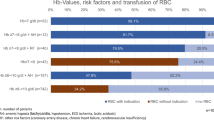Abstract
Objective
Most of published studies emphasized the medical cost of treating chemotherapy-induced anemia (CIA) by using specific agents, for example, epoetin α, epoetin β, darbepoetin α or combined with red blood cell transfusions, however, the investigation of the overall medical resources utilizations and economic burden of CIA is still limited. Besides, such studies which emphasized Chinese population still lack. The aim of this study is to investigate the medical resource utilization and the economic burden of Chinese cancer patients with CIA by using a populational representative claim database.
Methods
The data for this study are from the 2000-2003 Population Health Insurance Research Database (PHIRD) in Taiwan. On the basis of issuing catastrophic illness cards in the enrollment data files, a total of 26,053 beneficiaries were identified from the PHIRD, who were newly diagnosed with these four cancers in 2001 and 2002 (2001: n=12,954; 2002: n=13099). A generalized linear model (GLM) was employed for analyzing the differences of medical resource utilization and economic burden between the anemic and non-anemic groups.
Results
Analyses showed that the anemic patients were significantly more likely to have longer length of hospital stay than non-anemic patients (P<0.05) across all these four cancers and in two study periods (except women breast cancer in 2002/03). As regards the health care expenditures, the average one-year total medical cost was USD$8,982 (2001/02) and USD$8,990 (2002/03) for anemic patients among these four cancers, and USD$7,769 (2001/02) and USD$7713 (2002/03) for non-anemic patients (P<0.0001). As for ambulatory costs, anemic patients’ was significantly higher than non-anemic patients’ for lung cancer (in 2001/02), women breast cancer (in 2001/02 and 2002/03) and the summarized data (in 2001/02). As for inpatient costs, anemic patients’ was significantly higher than non-anemic patients’ for gastric cancer (in 2002/03), colon and rectal cancer (in 2001/02 and 2002/03), lung cancer (in 2001/02 and 2002/03), women breast cancer (in 2001/02) and the summarized data (in 2001/02 and 2002/03).
Conclusion
This study is the first study to demonstrate that cancer patients who receive chemotherapy and with anemia utilize more medical resources and have heavier economic burden among Chinese cancer patients. Although the Population Health Insurance Program in Taiwan was established to provide more low-burdened medical care for all cancer patients, further effort is still needed to reduce the economic burden for cancer patients who have specific complications.
Similar content being viewed by others

References
Groopman JE, Itri LM. Chemotherapy-induced anemia in adults: incidence and treatment [J]. J Natl Cancer Inst 1999; 91:1616–1634.
Cella D. Quality of life and clinical decisions in chemotherapy-induced anemia [J]. Oncology (Williston Park) 2006; 20(8 Suppl 6):25–28.
Harper P, Littlewood T. Anaemia of cancer: impact on patient fatigue and long-term outcome [J]. Oncology 2005; 69(Suppl 2):27–.
Ziegler JA, Herrington JD. Current and future options for the treatment of chemotherapy- induced anaemia [J]. Expert Opin Investig Drugs 2006; 15:1051–1065.
Sheffield R, Sullivan SD, Saltiel E, Nishimura L. Cost comparison of recombinant human erythropoietin and blood transfusion in cancer chemotherapy-induced anemia [J]. Ann Pharmacother 1997; 31:15–22.
Barosi G, Marchetti M, Liberato NL. Cost-effectiveness of recombinant human erythropoietin in the prevention of chemo- therapy-induced anaemia [J]. Br J Cancer 1998; 78:781–787.
Griggs JJ, Blumberg N. Recombinant erythropoietin and blood transfusions in cancer chemotherapy-induced anemia [J]. Anticancer Drugs 1998; 9:925–932.
Meehan KR, Tchekmedyian NS, Smith RE, et al. Resource utilisation and time commitment associated with correction of anaemia in cancer patients using epoetin alfa [J]. Clin Drug Investig 2006; 26:593–601.
Lyman GH, Berndt ER, Kallich JD, et al. The economic burden of anemia in cancer patients receiving chemotherapy [J]. Value Health 2005; 8:149–156.
Ershler WB, Chen K, Reyes EB, et al. Economic burden of patients with anemia in selected diseases [J]. Value Health 2005;8:629–638.
Lu JF, Hsiao WC. Does universal health insurance make health care unaffordable? Lessons from Taiwan[J] Health Aff (Millwood) 2003; 22:77–88.
WHO. International Classification of Diseases [M]. 9th Revision. Clinical Modification. 1st ed. ed: Ann Arbor, MI: Commission on Professional and Hospital Activities, 1978.
Charlson ME, Pompei P, Ales KL, et al. A new method of classifying prognostic comorbidity in longitudinal studies: development and validation [J]. J Chronic Dis 1987; 40:373–383.
Manning WG, Newhouse JP, Duan N, et al. Health insurance and the demand for medical care: evidence from a randomized experiment et al. Am Econ Rev 1987; 77:251–277.
Berndt E, Crown W, Kallich J, et al. The impact of anaemia and its treatment on employee disability and medical costs [J]. Pharmacoeconomics 2005; 23:183–192.
Ho WL, Lin KH, Wang JD, et al. Financial burden of national health insurance for treating patients with transfusion-dependent thalassemia in Taiwan [J]. Bone Marrow Transplant 2006; 37: 569–574.
Liu CN, Yang MC. National health insurance expenditure for adult beneficiaries in Taiwan in their last year of life [J]. J Formos Med Assoc 2002; 101:552–559.
Lu CY, Lauderdale TL, Fang YH, et al. Disease burden and related medical costs of rotavirus infections in Taiwan [J]. BMC Infect Dis 2006; 6:176.
Lin HC, Chang WY, Tung YC. Factors related to dissatisfaction with the National Health Insurance among primary care physicians in Taiwan [J]. Chang Gung Med J 2003; 26:81–90.
Lu JF, Leung GM, Kwon S, et al. Horizontal equity in health care utilization evidence from three high-income Asian economies [J]. Soc Sci Med 2007; 64:199–212.
Author information
Authors and Affiliations
Corresponding author
Additional information
This work was supported by a grant from Roche Co., Taiwan.
Rights and permissions
About this article
Cite this article
Liu, CY., Liu, TW., Liu, JS. et al. Medical resource utilizations and economic burden in Chinese cancer patients with chemotherapy-induced anemia: A populational database study. Chin. J. Cancer Res. 20, 307–315 (2008). https://doi.org/10.1007/s11670-008-0307-6
Received:
Accepted:
Published:
Issue Date:
DOI: https://doi.org/10.1007/s11670-008-0307-6



